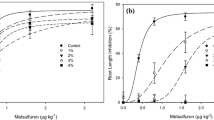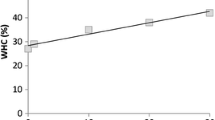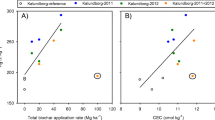Abstract
Background and Aims
Amendment of soil by biochar may reduce efficacy of soil-applied herbicides due to sorption.
Methods
Bioassays with Green Foxtail (Setaria viridis) tested the influence of two biochars on phytoavailability of S-metolachlor and sulfentrazone under biochar amendment of 0, 13, 26 and 52 Mg ha-1.
Results
Adsorption of both herbicides was an order of magnitude greater on a high specific surface area (SSA) biochar (EUC-800; SSA 242 m2 g-1) than on a low SSA biochar (BC-1; SSA 3.6 m2 g-1). Herbicide doses near the lowest recommended label rates controlled the weed at 13 and 26 Mg ha-1 of BC-1; sulfentrazone was also effective at 52 Mg BC-1 ha-1. These same herbicide doses controlled weed germination and development only at 13 Mg ha-1 of EUC-800; at herbicide doses near the highest label rates, weed control was also achieved at 26 Mg EUC-800 ha-1, but not at 52 Mg EUC-800 ha-1.
Conclusions
Increased doses of soil-applied herbicides cannot necessarily offset decreases in herbicide phytoavailability in biochar-amended soils, particularly if the biochar has a high SSA. Considering the long half-life of biochar in soil, pest control needs will be best served by low SSA biochars.




Similar content being viewed by others
References
Amonette JE, Joseph S (2009) Characteristics of biochar: microchemical properties. In: Lehmann J, Joseph S (eds) Biochar for environmental management: science and technology. Earthscan, London, pp 33–52
Bagreev A, Bandosz TJ, Locke DC (2001) Pore structure and surface chemistry of adsorbents obtained by pyrolysis of sewage-derived fertilizer. Carbon 39:1971–1979
Blackwell P, Riethmuller G, Collins M (2009) Biochar application to soil. In: Lehmann J, Joseph S (eds) Biochar for environmental management: science and technology. Earthscan, London, pp 207–226
Borisover M, Graber ER (2002) Simplified link solvation model (LSM) for sorption in natural organic matter. Langmuir 18:4775–4782
Borisover M, Graber ER (2003) Classifying NOM—organic sorbate interactions using compound transfer from an inert solvent to the hydrated sorbent. Environ Sci Technol 37:5657–5664
Bornemann LC, Kookana RS, Welp G (2007) Differential sorption behaviour of aromatic hydrocarbons on charcoals prepared at different temperatures from grass and wood. Chemosphere 67:1033–1042
Braida WJ, Pignatello JJ, Lu YF, Ravikovitch PI, Neimark AV, Xing BS (2003) Sorption hysteresis of benzene in charcoal particles. Environ Sci Technol 37:409–417
Brown RA, Kercher AK, Nguyen TH, Nagle DC, Ball WP (2006) Production and characterization of synthetic wood chars for use as surrogates for natural sorbents. Org Geochem 37:321–333
Chan KY, Van Zwieten L, Meszaros I, Downie A, Joseph S (2008) Using poultry litter biochars as soil amendments. Austral J Soil Res 46:437–444
Chan KY, Xu Z (2009) Biochar: nutrient properties and their enhancement. In: Lehmann J, Joseph S (eds) Biochar for environmental management: science and technology. Earthscan, London, pp 67–84
Chen B, Zhou D, Zhu L (2008) Transitional adsorption and partition of nonpolar and polar aromatic contaminants by biochars of pine needles with different pyrolytic temperatures. Environ Sci Technol 42:5137–5143
Chen BL, Chen ZM (2009) Sorption of naphthalene and 1-naphthol by biochars of orange peels with different pyrolytic temperatures. Chemosphere 76:127–133
Cheng CH, Lehmann J (2009) Ageing of black carbon along a temperature gradient. Chemosphere 75:1021–1027
Cheng CH, Lehmann J, Engelhard MH (2008) Natural oxidation of black carbon in soils: changes in molecular form and surface charge along a climosequence. Geochim Cosmochim Acta 72:1598–1610
Cheng CH, Lehmann J, Thies JE, Burton SD, Engelhard MH (2006) Oxidation of black carbon by biotic and abiotic processes. Org Geochem 37:1477–1488
Chiou CC, Manes M (1973) Application of the Polanyi adsorption potential theory to adsorption from solution on activated carbon. Iv. Steric factors, as illustrated by the adsorption of planar and octahedral metal acetylacetonates. J Phys Chem 77:809–813
Chun Y, Sheng G, Chiou CT, Xing B (2004) Compositions and sorptive properties of crop residue-derived chars. Environ Sci Technol 38:4649–4655
Cornelissen G, Elmquist M, Groth I, Gustafsson O (2004) Effect of sorbate planarity on environmental black carbon sorption. Environ Sci Technol 38:3574–3580
Cornelissen G, Gustafsson O, Bucheli TD, Jonker MTO, Koelmans AA, Van Noort PCM (2005) Extensive sorption of organic compounds to black carbon, coal, and kerogen in sediments and soils: mechanisms and consequences for distribution, bioaccumulation, and biodegradation. Environ Sci Technol 39:6881–6895
Elad Y, Rav David D, Meller Harel Y, Borenshtein M, Ben Kalifa H, Silber A, Graber ER (2010) Induction of systemic resistance in plants by biochar, a soil-applied carbon sequestering agent. Phytopathology 100:913–921
Gaskin JW, Steiner C, Harris K, Das KC, Bibens B (2008) Effect of low-temperature pyrolysis conditions on biochar for agricultural use. Trans ASABE 51:2061–2069
Gimeno O, Plucinski P, Kolaczkowski ST, Rivas FJ, Alvarez PM (2003) Removal of the herbicide MCPA by commercial activated carbons: equilibrium, kinetics, and reversibility. Ind Engin Chem Res 42:1076–1086
Glaser B, Lehmann J, Zech W (2002) Ameliorating physical and chemical properties of highly weathered soils in the tropics with charcoal—a review. Biol Fert Soils 35:219–230
Graber ER, Meller-Harel Y, Kolton M, Cytryn E, Silber A, Rav David D, Tsechansky L, Borenshtein M, Elad Y (2010) Biochar impact on development and productivity of pepper and tomato grown in fertigated soilless media. Plant Soil 337:481–496
Graber ER, Tsechansky L, Khanukov J, Oka Y (2011) Sorption, volatilization and efficacy of the fumigant 1,3-dichloropropene in a biochar-amended soil. Soil Sci Soc Am J 75:1365–1373
James G, Sabatini DA, Chiou CT, Rutherford D, Scott AC, Karapanagioti HK (2005) Evaluating phenanthrene sorption on various wood chars. Water Research 39:549–558
Jones DL, Edwards-Jones G, Murphy DV (2011) Biochar mediated alterations in herbicide breakdown and leaching in soil. Soil Biol Biochem 43:804–813
Kolton M, Meller Harel Y, Pasternak Z, Graber ER, Elad Y, Cytryn E (2011) Impact of biochar application to soil on the root-associated bacterial community structure of fully developed greenhouse pepper plants. Appl Environ Microbiol 77:4924–4930
Kookana RS (2010) The role of biochar in modifying the environmental fate, bioavailability, and efficacy of pesticides in soils: a review. Austral J Soil Res 48:627–637
Kwon S, Pignatello JJ (2005) Effect of natural organic substances on the surface and adsorptive properties of environmental black carbon (char): pseudo pore blockage by model lipid components and its implications for n-2-probed surface properties of natural sorbents. Environ Sci Technol 39:7932–7939
Laird DA (2008) The charcoal vision: a win-win-win scenario for simultaneously producing bioenergy, permanently sequestering carbon, while improving soil and water quality. Agron J 100:178–181
Lehmann J (2007a) Bio-energy in the black. Front Ecol Environ 5:381–387
Lehmann J (2007b) A handful of carbon. Nature 447:143–144
Lehmann J, da Silva P, Jr J, Steiner C, Nehls T, Zec W, Glaser B (2003) Nutrient availability and leaching in an archaeological anthrosol and a ferralsol of the central amazon basin: fertilizer, manure and charcoal amendments. Plant Soil 249:343–357
Loganathan VA, Feng YC, Sheng GD, Clement TP (2009) Crop-residue-derived char influences sorption, desorption and bioavailability of atrazine in soils. Soil Sci Soc Am J 73:967–974
Lookchem (2011) Look for Chemicals. www.lookchem.com. last accessed: 12-Jun-2011
Lua AC, Yang T, Guo J (2004) Effects of pyrolysis conditions on the properties of activated carbons prepared from pistachio-nut shells. J Anal Appl Pyrol 72:279–287
Matsui Y, Knappe DRU, Iwaki K, Ohira H (2002) Pesticide adsorption by granular activated carbon adsorbers. 2. Effects of pesticide and natural organic matter characteristics on pesticide breakthrough curves. Environ Sci Technol 36:3432–3438
Nag SK, Kookana RS, Smith L, Krull E, Macdonald LM, Gill G (2011) Poor efficacy of herbicides in biochar-amended soils as affected by their chemistry and mode of action. Chemosphere 84:1572–1577
PAN Pesticides Database (2010) http://www.pesticideinfo.org/. last accessed: 12-Dec-2010.
Pignatello JJ, Kwon S, Lu YF (2006) Effect of natural organic substances on the surface and adsorptive properties of environmental black carbon (char): Attenuation of surface activity by humic and fulvic acids. Environ Sci Technol 40:7757–7763
PPDB (2011) Pesticide Properties Database. http://sitem.herts.ac.uk/aeru/footprint/en/. last accessed: 3-Jan-2011
Rhodes AH, Carlin A, Semple KT (2008) Impact of black carbon in the extraction and mineralization of phenanthrene in soil. Environ Sci Technol 42:740–745
Rivard L (2003) Environmental fate of metolachlor. Environmental Monitoring Branch. Dept of Pesticide Registration, Sacramento CA, p 14
Sander M, Pignatello JJ (2007) On the reversibility of sorption to black carbon: distinguishing true hysteresis from artificial hysteresis caused by dilution of a competing adsorbate. Environ Sci Technol 41:843–849
Sheng GY, Yang YN, Huang MS, Yang K (2005) Influence of pH on pesticide sorption by soil containing wheat residue-derived char. Environ Poll 134:457–463
Silber A, Levkovitch I, Graber ER (2010) pH-dependent mineral release and surface properties of cornstraw biochar: agronomic implications. Environ Sci Technol 44:9318–9323
Smernik RJ (2009) Biochar and sorption of organic compounds. In: Lehmann J, Joseph S (eds) Biochar for environmental mangement: science and technology. Earthscan, London, pp 289–300
Spokas KA, Koskinen WC, Baker JM, Reicosky DC (2009) Impacts of woodchip biochar additions on greenhouse gas production and sorption/degradation of two herbicides in a minnesota soil. Chemosphere 77:574–581
Steiner C, Glaser B, Teixeira WG, Lehmann J, Blum WEH, Zech W (2008) Nitrogen retention and plant uptake on a highly weathered central amazonian ferralsol amended with compost and charcoal. J Plant Nutr Soil Sci 171:893–899
Tamon H, Okazaki M (1996) Desorption characteristics of aromatic compounds in aqueous solution on solid adsorbents. Journal of Colloid and Interface Science 179:181–187
Toth J, Milham PJ, Kaldor CJ (1999) Decreased phytotoxicity of diuron applied over ash of recently burned kangaroo grass (Themeda australis (r.Br.) stapf). Plant Prot Quart 14:151–154
USEPA (1997) Sulfentrazone pesticide fact sheet. Office of Prevention, Pesticides and Toxic Substances (7501C), Washington D.C.
Wang HL, Lin KD, Hou ZN, Richardson B, Gan J (2010) Sorption of the herbicide terbuthylazine in two new zealand forest soils amended with biosolids and biochars. Journal of Soils and Sediments 10:283–289
Woolf D, Amonette JE, Street-Perrott FA, Lehmann J, Joseph S (2010) Sustainable biochar to mitigate global climate change. Nat Commun 1:56
Wu C, Zhang XL, Li GB (2007) Effects of humic acid coatings on phenanthrene sorption to black carbon. J Environ Sci—China 19:1189–1192
Xia G, Ball WP (1998) Adsorption-partitioning uptake of nine low-polarity organic chemicals on a natural sorbent. Environ Sci Technol 33:262–269
Xu C, Liu WP, Sheng GD (2008) Burned rice straw reduces the availability of clomazone to bamyardgrass. Sci Total Environ 392:284–289
Yang XB, Ying GG, Peng PA, Wang L, Zhao JL, Zhang LJ, Yuan P, He HP (2010) Influence of biochars on plant uptake and dissipation of two pesticides in an agricultural soil. J Agric Food Chem 58:7915–7921
Yang Y, Hunter W, Tao S, Gan J (2009) Effects of black carbon on pyrethroid availability in sediment. J Agric Food Chem 57:232–238
Yang YN, Chun Y, Sheng GY, Huang MS (2004) pH-dependence of pesticide adsorption by wheat-residue-derived black carbon. Langmuir 20:6736–6741
Yang YN, Sheng GY (2003) Pesticide adsorptivity of aged particulate matter arising from crop residue burns. J Agric Food Chem 51:5047–5051
Yang YN, Sheng GY, Huang MS (2006) Bioavailability of diuron in soil containing wheat-straw-derived char. Sci Total Environ 354:170–178
Yu X-Y, Ying G-G, Kookana RS (2009) Reduced plant uptake of pesticides with biochar additions to soil. Chemosphere 76:665–671
Yu XY, Pan LG, Ying GG, Kookana RS (2010) Enhanced and irreversible sorption of pesticide pyrimethanil by soil amended with biochars. J Environ Sci—China 22:615–620
Yu XY, Ying GG, Kookana RS (2006) Sorption and desorption behaviors of diuron in soils amended with charcoal. J Agric Food Chem 54:8545–8550
Zeng GM, Zhang C, Huang GH, Yu J, Wang Q, Li JB, Xi BD, Liu HL (2006) Adsorption behavior of bisphenol a on sediments in xiangjiang river, central-south china. Chemosphere 65:1490–1499
Zhang JH, He MC (2010) Effect of structural variations on sorption and desorption of phenanthrene by sediment organic matter. Journal of Hazardous Materials 184:432–438
Zhang P, Sheng GY, Feng YH, Miller DM (2006) Predominance of char sorption over substrate concentration and soil pH in influencing biodegradation of benzonitrile. Biodegradation 17:1–8
Zheng W, Guo M, Chow T, Bennett DN, Rajagopalan N (2010) Sorption properties of greenwaste biochar for two triazine pesticides. J Haz Mat 181:121–126
Zimmerman AR (2010) Abiotic and microbial oxidation of laboratory-produced black carbon (biochar). Environ Sci Technol 44:1295–1301
Acknowledgments
Setaria viridis seeds were provided by Prof. Baruch Rubin, and sulfentrazone by Dr. Yael Mishael, both of the Hebrew University of Jerusalem; their generosity is gratefully acknowledged. We greatly appreciate the careful and detailed reviews by the referees. This research was made possible by a grant from the Chief Scientist of the Ministry of Agriculture and Rural Development (project number 301-0693-10). This paper is contribution no. 604/11 of the Agricultural Research Organization, The Volcani Center, Israel.
Author information
Authors and Affiliations
Corresponding author
Additional information
Responsible Editor: Johannes Lehmann.
Rights and permissions
About this article
Cite this article
Graber, E.R., Tsechansky, L., Gerstl, Z. et al. High surface area biochar negatively impacts herbicide efficacy. Plant Soil 353, 95–106 (2012). https://doi.org/10.1007/s11104-011-1012-7
Received:
Accepted:
Published:
Issue Date:
DOI: https://doi.org/10.1007/s11104-011-1012-7




